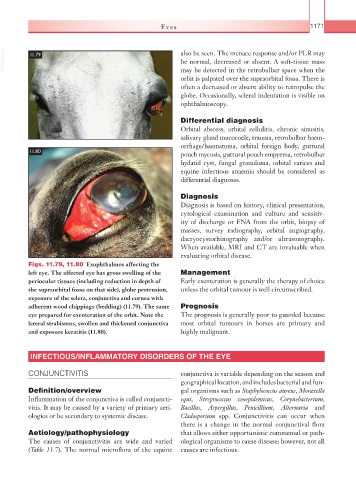Page 1196 - Equine Clinical Medicine, Surgery and Reproduction, 2nd Edition
P. 1196
Eyes 1171
VetBooks.ir 11.79 also be seen. The menace response and/or PLR may
be normal, decreased or absent. A soft-tissue mass
may be detected in the retrobulbar space when the
orbit is palpated over the supraorbital fossa. There is
often a decreased or absent ability to retropulse the
globe. Occasionally, scleral indentation is visible on
ophthalmoscopy.
Differential diagnosis
Orbital abscess, orbital cellulitis, chronic sinusitis,
salivary gland mucocoele, trauma, retrobulbar haem-
orrhage/haematoma, orbital foreign body, guttural
11.80 pouch mycosis, guttural pouch empyema, retrobulbar
hydatid cyst, fungal granuloma, orbital varices and
equine infectious anaemia should be considered as
differential diagnoses.
Diagnosis
Diagnosis is based on history, clinical presentation,
cytological examination and culture and sensitiv-
ity of discharge or FNA from the orbit, biopsy of
masses, survey radiography, orbital angiography,
dacryocystorhinography and/or ultrasonography.
When available, MRI and CT are invaluable when
evaluating orbital disease.
Figs. 11.79, 11.80 Exophthalmos affecting the
left eye. The affected eye has gross swelling of the Management
periocular tissues (including reduction in depth of Early exenteration is generally the therapy of choice
the supraorbital fossa on that side), globe protrusion, unless the orbital tumour is well circumscribed.
exposure of the sclera, conjunctiva and cornea with
adherent wood chippings (bedding) (11.79). The same Prognosis
eye prepared for exenteration of the orbit. Note the The prognosis is generally poor to guarded because
lateral strabismus, swollen and thickened conjunctiva most orbital tumours in horses are primary and
and exposure keratitis (11.80). highly malignant.
INFECTIOUS/INFLAMMATORY DISORDERS OF THE EYE
CONJUNCTIVITIS conjunctiva is variable depending on the season and
geographical location, and includes bacterial and fun-
Definition/overview gal organisms such as Staphylococcus aureus, Moraxella
Inflammation of the conjunctiva is called conjuncti- equi, Streptococcus zooepidemicus, Corynebacterium,
vitis. It may be caused by a variety of primary aeti- Bacillus, Aspergillus, Penicillium, Alternaria and
ologies or be secondary to systemic disease. Cladosporium spp. Conjunctivitis can occur when
there is a change in the normal conjunctival flora
Aetiology/pathophysiology that allows either opportunistic commensal or path-
The causes of conjunctivitis are wide and varied ological organisms to cause disease; however, not all
(Table 11.7). The normal microflora of the equine causes are infectious.

